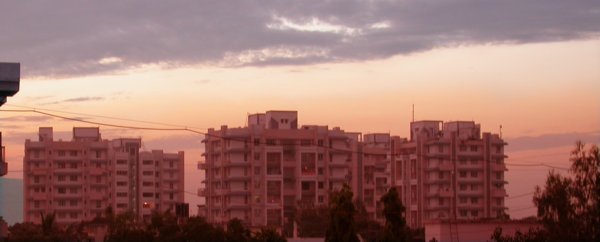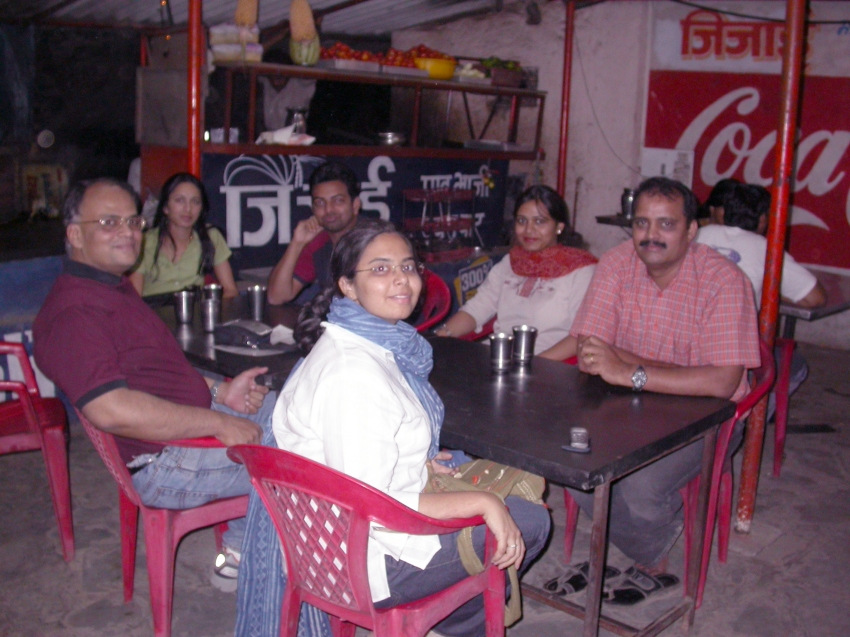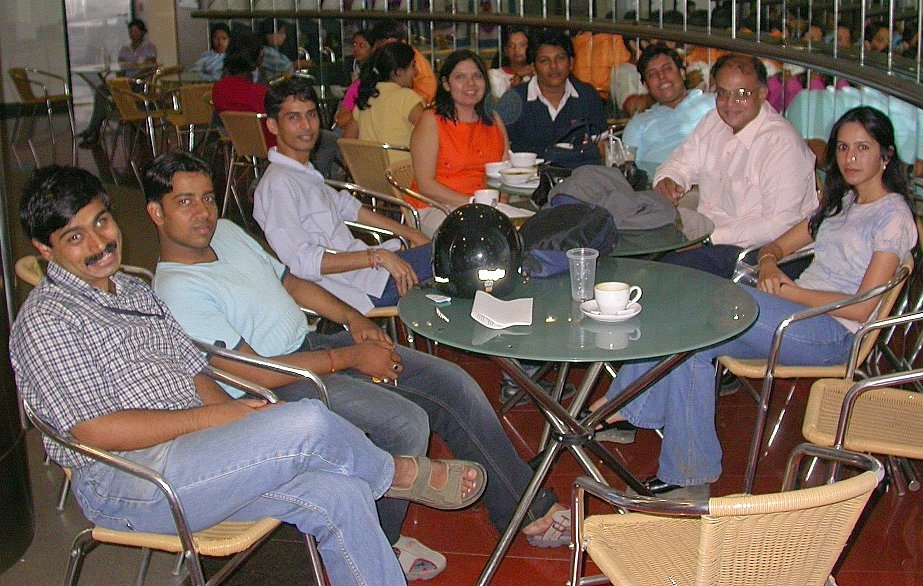 |

BAJI JAGANNATHA RAM RAO

| Have: |
Humility, Intelligence,
Opinions, Ideas,
Mystery, Depth, Reserve. |
|
Want: |
Good friends to discuss
profound thoughts, Outside-the-box thinking, Intense human experience. |
|
| Title: |
Division
Manager |
|
Home: |
Aundh,
Pune, Maharashtra
India |
| Company: |
Neilsoft
Ltd. |
|
From: |
Mumbai,
Maharashtra
India |
| Industry Category: |
|
|
Universities: |
BE(Electronics
&
Communications
Engg.)
1980
University of Mysore |
| Industries: |
Engineering
Tech. software, Embedded
Systems, Medical Informatics, |
|
Interests: |
Friendship,
Pervasive
Computing, Cars,
Aircraft, Digital-Photography, Travel |
| Experience: |
| Sr. Technology
Specialist |
|
Disha Technologies
(India) Limited |
|
Jul 2004 - Mar 2005 |
|
| Founder
& Managing Director |
|
Bajirao
Technologies Private Limited |
|
Nov 2001 - Jun 2004 |
|
| CEO |
|
e-SmartNET,
(Zicom Electronic Security Sys. Ltd.) |
|
Jan 2000 - Apr 2001 |
|
| COO |
|
Mindteck
India Limited |
|
Sep 1999 - Jan 2000 |
|
| President |
|
Rotary
Club of Bombay Chembur West |
|
Jul 1999 - Jun 2000 |
|
| Vice
President & COO |
|
Hinditron
Informatics Limited |
|
Dec 1997 - Sep 1999 |
|
| General
Manager (Projects) |
|
Tata
Technologies Pte. Ltd., Singapore |
|
Mar 1997 - Oct 1997 |
|
| Manager
(Projects) |
|
Larsen
& Toubro Information Systems Div. |
|
Oct 1992 - Mar 1997 |
|
| ASAP
to Asst. Consultant |
|
Tata
Consultancy Services |
|
Oct 1982 - Oct 1992 |
|
| Scientific
Officer |
|
SMPU,
Tata Institute of Fundamental Research |
|
Aug 1981 - Sep 1982 |
|
| Embedded
Software Designer |
|
Applied
Electronics Ltd. (Aplab) |
|
Jan 1981 - Aug 1981 |
|

My
coral, white and slate abode, against a coral, white and slate sky
|

HP
pump on Mumbai-Pune expwy at Sajgaon,Raigad refuels Neeta Volvo coach.
Foodtrack, the travelers!
|

Heartstrings
brace interlocking friendship rings between Pune & Bremen,
Germany. p-b-Maitry Chowk, Aundh
|

Shooting
the breeze over coffee at Chandni Chowk
after the Sun. 13-Mar. Caferati
Readmeet at Max's
|

Coffee at E-Square after the Sun. 28-Aug.
Caferati Readmeet at
Sujit Patwardhan's
|
The
land of imagination for which we long, shines through the world of
our photographs…
|
Hi, I am Baji Jagannatha Ram Rao.
I
was born and educated in Bombay
(since 1996 called Mumbai). Aside from eight years spent overseas my
workplace has mostly been Mumbai.
After
completing my BE in electronics &
communications engineering, I have enjoyed a fulfilling twenty-four
year career
to date which included
ten years with Tata
Consultancy Services
and five years with Larsen &
Toubro Ltd, executing software
projects with IBM, upstate New York,
Hewlett-Packard, Lake Stevens, Wa, an electronic design automation
company in Los Gatos, Ca, Bell-Northern Research Canada, Europe's
largest cargo-container stevedoring and transhipment company in
Rotterdam, the Netherlands, Sweden's leading electricity and heat
supplier, Vattenfall Group and Matsushita Systems Engg, Japan.
In the
late 1990s I was COO of Mindteck
(India) Ltd. and CEO of
e-SmartNET, a division of Zicom Electronic
Security Systems Ltd. We delivered services in the exciting domain of
embedded systems.
In
2002, I founded Bajirao Technologies
Pvt. Ltd., a
medical informatics startup based in Chembur, Mumbai, India. Having
worked almost a quarter-century worldwide since 1981, my compatriots
and I got India, globally recognized in infotech. Aren’t we
rightfully
proud!
Having worn many hats from
R&D
engineer to founder-entrepreneur president, I currently manage the
software division at one of India's most promising tier-1 engineering tech.
services
companies. My division develops CAD
products,
bespoke CAD/CAM/CAE software in the ship-design
(outfitting), diecasting, heat exchangers, configurators, and
cataloging space, and delivers independent
third-party software product testing and localization engineering
services to Fortune 500 engineering companies in the US, Europe and
the Orient.
Currently I live in Aundh, Pune.
Love
reading Tracy Kidder’s “The
Soul Of A
New Machine”, Rich
Bach’s “Jonathan Livingstone Seagull” and
Paulo
Coelho’s “The Alchemist”.
Love to
travel and visit places.
Personally,
I have a passion
for
automobiles. Eight years overseas gave ample opportunity to own and
lease many interesting varieties. Among these were a Ford Tempo, a
Pontiac 1000, a Dodge Aries, a Ford Maverick, a Mercedes 190-E W201, a
Ford Sierra, an Opel Rekord, a Ford Taunus-Cortina, a Ford Mustang, a
Pontiac Catalina Safari wagon (my land-yacht), a four-wheel-drive
Mahindra MM540, two Daewoo Cielos, a twin-cam 16-valve Daewoo Nexia. I
used to run a weekly spot-the-car contest at www.cybersteering.com. Another fascination I've always had is for piston-engined propeller airliners -- what are now classic propliners.
|
|
The Intel 8080, the
first real microprocessor that ushered in the microcomputer revolution
was announced in
April 1974. I was an Inter Sc. Student at SIES, Sion. The
following summer in 1975, I joined engineering college.
I was at Manipal
Institute
of Technology from 1975 to 1980.
My father’s friend at BARC, Mr. B. R. Bairi hailed from
Udipi. When he visited his parents, he stopped by
at my engineering college to meet me. It was Diwali 1975.
We talked computers. I didn’t know much but was
full of curiosity. I had a hand-held 4-function
calculator-- a Casio Pocket-Mini.
Its CPU and display driver were integrated in one chip(μPD974C).
It had an eight-digit vaccuum fluorescent display. I had been trying to
fathom programming, reading a Fortran-IV programming textbook. The
Casio
calculator and Fortran stimulated interesting conversation. Bairi uncle
suggested that I come to Bhabha
Atomic
Research
Center (BARC) during the summer
vacations to get
hands-on training in computer programming. That year, Paul Allen and
Bill Gates wrote their BASIC interpreter for
the MITS Altair, the first hobby microcomputer and founded what would
become Microsoft.
Back then, BARC had
a Soviet BESM-6 (БЭСМ-6) mainframe. БЭСМ stands for
“Быстродействующая Электронно-Счетная Машина”
“Bystrodeystvuyushchaya Yelektronno-Schetnaya
Mashina”, meaning, “High-speed Electronic
Calculating Machine”. The BESM-6 was a 9-MHz, 1 MIPS, 48-bit
machine with 60,000 transistors and 1,70,000 diodes.
At college, we were
studying numerical methods. My first computer
program was to implement the Newton-Raphson root-finding algorithm to
find the roots of a polynomial.
So at BARC, in the summer of 1976, I used the powder-blue IBM Type 029
and Type 129 key punches to produce decks
of Hollerith cards with Fortran-IV source code. A deck was
submitted for batch-processing and in the morning a 132-column
drum-printed output would be waiting for me
in my pigeon-hole in the varnished plywood rack at BARC North site.
Back in the late
seventies, computer architecture was implemented with TTL
chips
and MSI
logic. As an engineering student
at BARC during
the Diwali-1976 holidays, I learned to program in
assembly language on an ECIL 16-bit TDC-316 mini. The
TDC-316 was inspired by the PDP-11 from Digital Equipment
Corp. (DEC),Maynard, Massachusetts.
In 1976 DEC
announced their first 32-bit supermini: the VAX series.
Suddenly the current 16-bit machines were outdated.
Data-General immediately launched their own 32-bit effort
to beat DEC to market. They called it the “Fountainhead
Project”. However, two years later in 1978, the VAX 11/780
was released. Fountainhead proj. mgmt. had failed
to beat DEC to market. DG then killed Fountainhead and
launched their “Eagle Project” a crash 32-bit
effort
based on the Eclipse.
Tracy Kidder's 1981 book, “The
Soul Of A
New Machine” described
these travails. The book won the Pulitzer. The DG Eclipse MV/8000 was
finally delivered in 1980, the year I graduated.
Going back, the
September 1977 issue of the Scientific
American, was an eye-opener. I
convinced my college librarian to let me borrow the library reference
copy long enough to photocopy it. In 1977, photocopying was a laborious
expensive process.
The plain-paper xerographic electrophotocopier
was the size of an autorickshaw.
You mounted the page to be photocopied on an easel.
Then the photographer would charge a selenium-coated photo-receptor
plate with static electricity.
He would then place the plate into his bellows-type view camera and
photograph (shoot) the page.
The plate with an electrostatic image would then be placed in an
aluminum box and dusted with fine black toner powder.
The toner would stick forming an image on the plate, which would then
be placed in a “fixer” along with the paper.
A heat-fixing process would cause the toner to adhere to the paper.
Using this wonderful machine, I copied the whole Sept.’77
issue of the Scientific American. That photocopy marked a watershed in
my engineering ambitions. It inspired me to build a career on the
microcomputer frontier.
Computer design has
made great strides since the Intel 8080. An
ever-increasing amount of functionality is integrated in-silicon.
CPU-design battles are now fought with large gate count, IP-based,
bus-intensive system-on-chips (SoC), designed using SystemVerilog.
The essential spirit of the high-tech industry,
the feverish pace, the mystique, the go-for-broke
approach to business continues, as the industry pursues mind-bending
technological innovations with new blood pouring out of the engineering
colleges.
|
On
Yahoo! Messenger

|
"There is
hardly
anything in the world that somebody cannot worsen a little, sell a
little cheaper and rightfully prey on people who consider price only.
"It's unwise
to
pay
too much, but it's self-defeating to pay too little.
When you pay too much you lose a little money, That is all.
When you pay too little, you sometimes lose everything because
the product or service you bought was incapable of the exact function
you intended.
The
common law
of business balance prohibits paying a little and getting a lot. It
cannot be done.
If you deal
with
the
lowest bidder, it is sensible to put something away for the risk you
run. And if you do that, you will have enough to pay for something
better."
John
Ruskin (1819..1900) Philosopher, Author
|
Quality
costs money
Is your business worth the investment?
|
|
What
is as difficult to secure as
friendship?
And what greater security is there against enemies?
Among
the wise, friendship grows like the
crescent moon; Among fools it shrinks as surely as the full moon must.
The
bonds that good people
share, like good bound books, Reveal new pleasure with each new
encounter.
The
object of friendship is not merrymaking, But
a stern rebuking when friends go astray.
It is not constant meeting and companionship, But mutual sensibilities
that confer the alliance of friendship.
Friendship is not seen on a friendly face, But felt deep within a
friendly heart.
To divert a friend from wrong, direct them toward the right, And share
their sorrow in misfortune is friendship.
As swiftly as the hand moves to stop a slipping dress, Friendship acts
to assuage a friend's distress.
Just
think…
We humans are social beings, born
unwittingly as the result of
others’
actions. Our daily survival depends on other human beings. Our every
living moment benefits from others’ activities.
The only way to be happy, alleviate
anxiety, doubt and disappointment
is:
for us to have a genuine
concern for others and
strive for happy relationships.
Keys to genuine human happiness: Love, Compassion,
Patience, Tolerance and Forgiveness
| देख ले, आँखों में आँखें डाल, |
Look (at life),
straight in the eye |
| सीख ले, हर पल में जीना यार, |
Learn, to live in
every moment |
| सोच ले, जीवन के पल हैं चार, |
Think: Life is
barely four moments long |
| याद रख, मरना है एक बार |
Remember: we must
die only once |
| मरने से पहले जीना, सीख ले |
Before you die,
learn to live |
|

